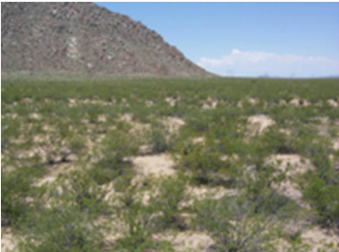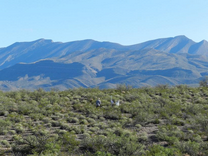Research at the Jornada Basin LTER and other drylands shows that shrub-dominated ecosystems are more dynamic than previously believed, and are difficult to forecast under global change. Will drought-avoiding mesquite give way to creosotebush, a true xerophyte? Will tarbush be lost entirely or expand under future climatic conditions? Will aeolian and hydrologic processes, and interactions with biotic crusts, differentially influence shrub functional groups? Long term data and experiments at the Jornada are helping to illuminate these understudied ecosystems.
Research Highlights

Mechanisms of Shrubland Transitions
Topo-edaphic factors ostensibly control the broad-scale distribution and abundance of major shrub species (mesquite, creosotebush, tarbush) throughout the Chihuahuan Desert. However, time-series vegetation maps dating to 1858 reveal these shrub communities and the states they represent have been dynamic through space, and their distributions are not entirely controlled by soils (Gibbens et al. 2005). Re-analysis of historic vegetation maps in 1858 revealed that the entire bajada was perennial grassland with scattered plants of mesquite, creosote and tarbush. Mesquite proliferation was evident in the basin in 1915, whereas the bajada was tarbush-dominated by this time. Creosotebush then displaced tarbush on the upper bajada by 1928, with tarbush communities persisting on the lower bajada. By 1998, mesquite, tarbush and creosotebush shrublands characterized the basin, lower bajada and upper bajada, respectively, while tarbush and mesquite were important sub-dominants in the bajada communities. Differences in long distance seed dispersal are thus not an explanation for contrasting patterns of proliferation. Because all three species are long-lived (decades to centuries), we evaluated explanations related to differences in functional traits related to seed germination/seedling survival responses to soils, PPT, and microbial interactions in lab/greenhouse experiments. This data is filling knowledge gaps in key shrub demographic parameters.
PIs: Debra Peters, Steven Archer

Photo Credit: ASU
Watershed Ecohydrology and Land-Atmosphere Interaction Studies
Recent studies revealed that 25% of incoming PPT on the bajada is lost via channel recharge (Schreiner-McGraw et al. 2017), thus bypassing ecosystem water use and reducing rain-use efficiency (Biederman et al. 2018). This is consistent with low summertime ET in the eddy covariance footprint (Anderson and Vivoni 2016). At the Jornada Basin LTER, we quantified infiltration rates in soils associated with creosotebush, tarbush, and mesquite shrubs on varying landscape positions. Initial tRIBS simulations suggest vegetation change will overwhelm climate change effects on runoff on the bajada (Schreiner-McGraw et al. 2019).
PI: Enrique Vivoni